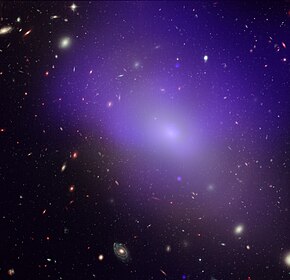NGC 1132
Appearance
This article, NGC 1132, has recently been created via the Articles for creation process. Please check to see if the reviewer has accidentally left this template after accepting the draft and take appropriate action as necessary.
Reviewer tools: Inform author |
| NGC 1132 | |
|---|---|
 A visible light image of NGS1132 with X-ray emission superimposed (rendered in blue) | |
| Observation data | |
| Pronunciation | en |
| Right ascension | 02h 52m 51.82s |
| Declination | −01° 16′ 29.0″ |
| Redshift | 6,871 km/s |
| Apparent magnitude (B) | 13.9 |
| Characteristics | |
| Type | E |
| Other designations | |
| UGC 2359 | |
References: "NGC 1132". Simbad. Université de Strasbourg/CNRS. Retrieved September 24, 2020. | |
NGC 1132 is an elliptical galaxy located in the constellation Eridanus.[1] The galaxy was discovered by John Herschel on November 23, 1827.[citation needed] It is located at a distance of about 318 million light-years away from Earth.[2] NGC 1132 and nearby small galaxies are known as a "fossil group" that resulted from the merger of a group of galaxies.[1] It is notable for being the prototype example of the class of fossil galaxy groups.[3] The identification as a fossil group was made in 1999.[4] This group contains an enormous amount of dark matter and a large amount of hot gas that emits X-ray radiation.[5] The galaxy is surrounded by thousands of globular star clusters.[6]
References
- ^ a b "Gargantuan galaxy NGC 1132 - a cosmic fossil?". Hubble Space Telescope. NASA/ESA. February 5, 2008. Retrieved September 24, 2020.
- ^ Nowakowski, Tomasz (June 27, 2017). "Galaxy NGC 1132 has a disturbed hot halo, study finds". Phys.org. Science X. Retrieved September 24, 2020.
- ^ Alamo-Martínez1, K. A.; West1, M. J.; Blakeslee, J. P.; González-Lópezlira, R. A.; Jordán, A.; Gregg, M.; Côté, P.; Drinkwater, M. J.; van den Bergh, S. (October 2012). "Globular cluster systems in fossil groups: NGC 6482, NGC1132,and ESO 306-017" (PDF). Astronomy & Astrophysics. 546 (A15): 1–14. doi:10.1051/0004-6361/201219285. Retrieved September 24, 2020.
{{cite journal}}: Cite has empty unknown parameter:|1=(help)CS1 maint: numeric names: authors list (link) - ^ Martínez, Álamo; Adriana, Karla (2015). Globular Clusters: Jewels to Trace the Structure of Galaxies (PDF). Universidad Nacional Autónoma de México. p. 65. ISBN 9786070268106.
- ^ "NGC 1132: A Mysterious Elliptical Galaxy". Chandra. NASA. February 5, 2008. Retrieved September 24, 2020.
- ^ "The Gargantuan Galaxy NGC 1132". Hubble. ESA. February 5, 2008. Retrieved September 24, 2020.
See also
![]() Media related to NGC 1132 at Wikimedia Commons
Media related to NGC 1132 at Wikimedia Commons
resubmit after fixing decline issues
This article, NGC 1132, has recently been created via the Articles for creation process. Please check to see if the reviewer has accidentally left this template after accepting the draft and take appropriate action as necessary.
Reviewer tools: Inform author |

